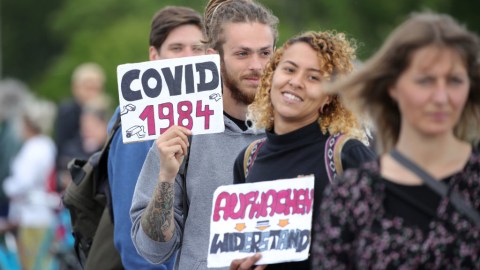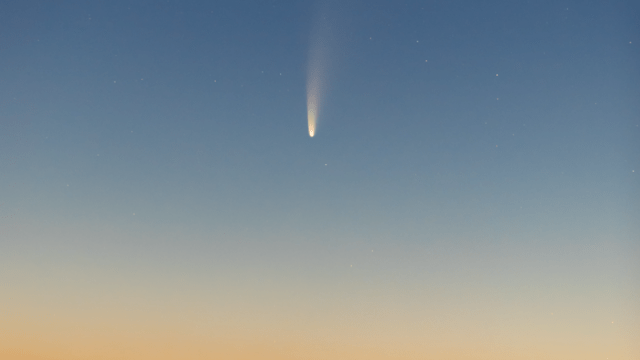The real-world effect of coronavirus conspiracy theories

Photo by Andreas Rentz/Getty Images
- New research finds that YouTube is the worst disseminator of coronavirus misinformation.
- People that rely on social media for their news are more likely to believe coronavirus conspiracy beliefs.
- With only 50 percent of Americans willing to get a vaccination, conspiracy theories are fueling a public health crisis.
As Florida becomes the global epicenter of the novel coronavirus pandemic with over 15,000 cases reported in one day and 3.3 million cases overall, a Windermere restaurant celebrated by offering free grilled cheese sandwiches to any customer showing up without a mask.
The region, and the entire state, has become a hotbed for coronavirus conspiracy theories—a microcosm of America. The nation leads the world in coronavirus infections by a lot. We likely lead the world in conspiracy theories about the virus as well. These phenomenons are not separate.
While it’s easy to roll your eyes at anti-mask crusades, new research, published in the journal Psychological Medicine, investigates the real-world effects of coronavirus conspiracy theories.
Corresponding author, Daniel Allington of King’s College London, analyzed data from three surveys regarding varying aspects of COVID-19 conspiracy beliefs. His team looked at responses from 5,453 UK residents. They were especially interested in how social media disseminates health misinformation. The findings will not surprise anyone with a social media account:
“All three studies found a negative relationship between COVID-19 conspiracy beliefs and COVID-19 health-protective behaviours, and a positive relationship between COVID-19 conspiracy beliefs and use of social media as a source of information about COVID-19.”
Allington identifies YouTube and Facebook as the primary drivers of misinformation. The unregulated nature of social media is cause for concern. In fact, the team discovered that people that consume regulated media, such as broadcast or print, are more likely to engage in protective health measures, such as wearing a mask and social distancing. The opposite is true for people that receive most of their health guidance from social media.
Coronavirus: Conspiracy Theories: Last Week Tonight with John Oliver (HBO)www.youtube.com
Allington’s team used data collected from partnerships with CitizenMe (Study 1) and Ipsos-MORI (Studies 2 and 3). In the first study, respondents had to identify the truth behind three conspiracy beliefs:
- The virus that causes COVID-19 was probably created in a laboratory
- The symptoms of COVID-19 seem to be connected to 5G mobile network radiation
- The COVID-19 pandemic was planned by certain pharmaceutical corporations and government agencies
Among their findings, younger people tend to buy into one or more conspiracy belief, while older respondents are more likely to engage in protective behaviors. Women listen to public health guidance more than men, though there is no gender distinction in those that believe in conspiracy theories.
Study 2 also asked about the possibility of the novel coronavirus being created in a laboratory, while Study 3 looked more deeply into the respondents’ usage of social media. In each case, the results were clear: people that rely on social media for news are more likely to peddle in conspiracy theories.
YouTube appears to be the most problematic source of misinformation. Slickly produced shows, such as London Real, feature prominent anti-vaxxers like Del Bigtree. The anti-vaxx propaganda film, “Plandemic,” was viewed over eight million times on YouTube before it was removed; the producer, Mikki Willis, is using this spotlight to raise funds for Part 2. These are only two examples in a deluge of anti-vaxx videos driving a dangerous narrative.
The danger is especially prevalent as a coronavirus vaccine becomes a possibility. Oxford University researchers have just discovered a strong candidate. Still, a June poll found that only 50 percent of Americans plan on getting a coronavirus vaccine. If anti-vaxx organizations continue to influence the public, less than half of this country could receive a vaccination.
In America, conspiracy beliefs are not only spread on social media. A recent study found Fox News pushing coronavirus misinformation 253 times over a five-day period. The going narrative is that vaccination is a question of “individual liberty,” and if you’re vaccinated you shouldn’t worry about the unvaccinated. As with other misinformation, this is false, exposing the real danger of coronavirus misinformation.

People participate in a Reopen New Jersey protest on May 25, 2020 in Point Pleasant, New Jersey.Photo by Michael Loccisano/Getty Images
In her book, “On Immunity,” writer Eula Biss asks readers to imagine vaccination “as a kind of banking of immunity.” When getting vaccinated, you contribute to a collective bank, ensuring those who cannot or will not get vaccinated are protected. Herd immunity only occurs when a population reaches a certain threshold; that threshold is well over 50 percent.
“The unvaccinated person is protected by the bodies around her, bodies through which disease is not circulating,” writes Biss. “But a vaccinated person is surrounded by bodies that host disease is left vulnerable to vaccine failure or fading immunity. We are protected not so much by our own skin, but by what is beyond it. The boundaries between our bodies begin to dissolve here.”
The prevalence of immunosuppressed individuals unable to get vaccinated is left out of this conversation. This is a growing concern in countries like America, where obesity has led to increasing numbers of immunosuppressed citizens.
While the myth that children are protected against the ravages of the coronavirus persists, the long-term complications of this multi-system disease are still becoming known, making anti-vaxx parents accountable for potential harm that may come.
Every citizen should be wary of a rushed vaccine. Researchers are attempting to create a vaccine faster than ever. There are inherent dangers in such a pursuit. But costs associated with rejecting any vaccine on the grounds of perceived “sovereignty” is even more dangerous. The price we’ll pay for this misinformation is higher than any society can bear.
—
Stay in touch with Derek on Twitter, Facebook and Substack. His next book is “Hero’s Dose: The Case For Psychedelics in Ritual and Therapy.”





